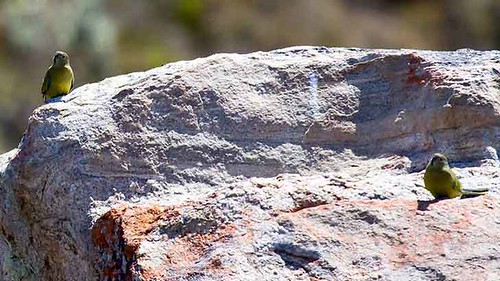Pet trade put paid to Rotto's pretty parrots
 Saturday, February 1, 2014 at 1:36
Saturday, February 1, 2014 at 1:36  A pair of rock parrots at Two People's Bay near Albany. Photo: Ian RedmondSurfers and anglers are familiar with the small green rock parrots that haunt our coastline and offshore islands.
A pair of rock parrots at Two People's Bay near Albany. Photo: Ian RedmondSurfers and anglers are familiar with the small green rock parrots that haunt our coastline and offshore islands.
However the once common spectacle of flocks of parrots wheeling over Rottnest's northern beaches has long past, and the unobtrusive little bird is in danger of vanishing from the island altogether.
The decline started in the 1940s, when Rottnest's breeding sites at Parakeet Bay, Little Parakeet Bay and Parakeet Island – all named after the birds – were raided for young parrots, which were sold as pets before budgerigars became widely available.
In the 1980s, the population appeared to be recovering, with flocks of up to 15 birds sighted, but today only small groups are seen.
Other than at Rottnest, however, rock parrots, also called rock elegants, are reasonably common.
Known as cowra to the Noongar, rock parrots are quiet birds that are easily approached when feeding on the seeds of the coastal grasses, shrubs and succulent plants that make up the main part of their diet.
Usually found in small groups, they are seldom seen more than a few hundred metres from the sea, and almost always feed on the ground, although they often perch on low branches and rocks.
In WA, rock parrots are found from Cape Arid National Park on the south coast to Shark Bay, where they frequent coastal dunes, salt marshes and rocky islets.
They breed from August to November, mainly on offshore islands, where they nest in rock crevices, abandoned seabird nesting burrows or on rocky ledges sheltered by scrub.
Here the females lay two to six eggs, which they incubate while the males feed them by regurgitation.
YOU CAN HELP
 A rock parrot displays its new leg band. Photo: Jenny StockYou can help preserve Rottnest's remaining rock parrots simply by keeping your eyes open next time you visit WA's favourite holiday isle.
A rock parrot displays its new leg band. Photo: Jenny StockYou can help preserve Rottnest's remaining rock parrots simply by keeping your eyes open next time you visit WA's favourite holiday isle.
To determine how many rock parrots remain on Rottnest and what could be contributing to their decline, visitors to the island are asked to report any sightings – including the number of birds, where and when they were seen, and if they had coloured bands on their legs – to James Sansom at boldparkbirdbanding@hotmail.com.
 Neophema petrophila - Rock Parrot | in
Neophema petrophila - Rock Parrot | in  Conservation,
Conservation,  Research
Research 
